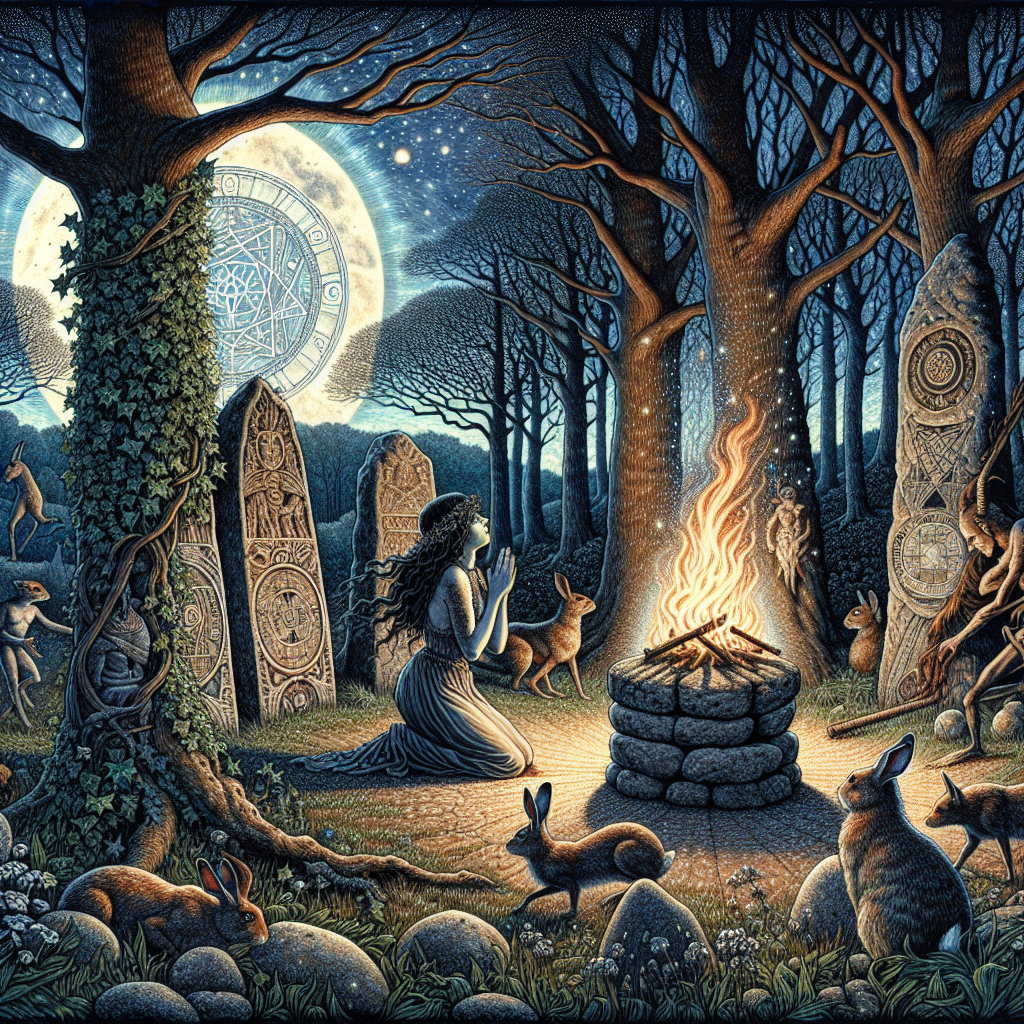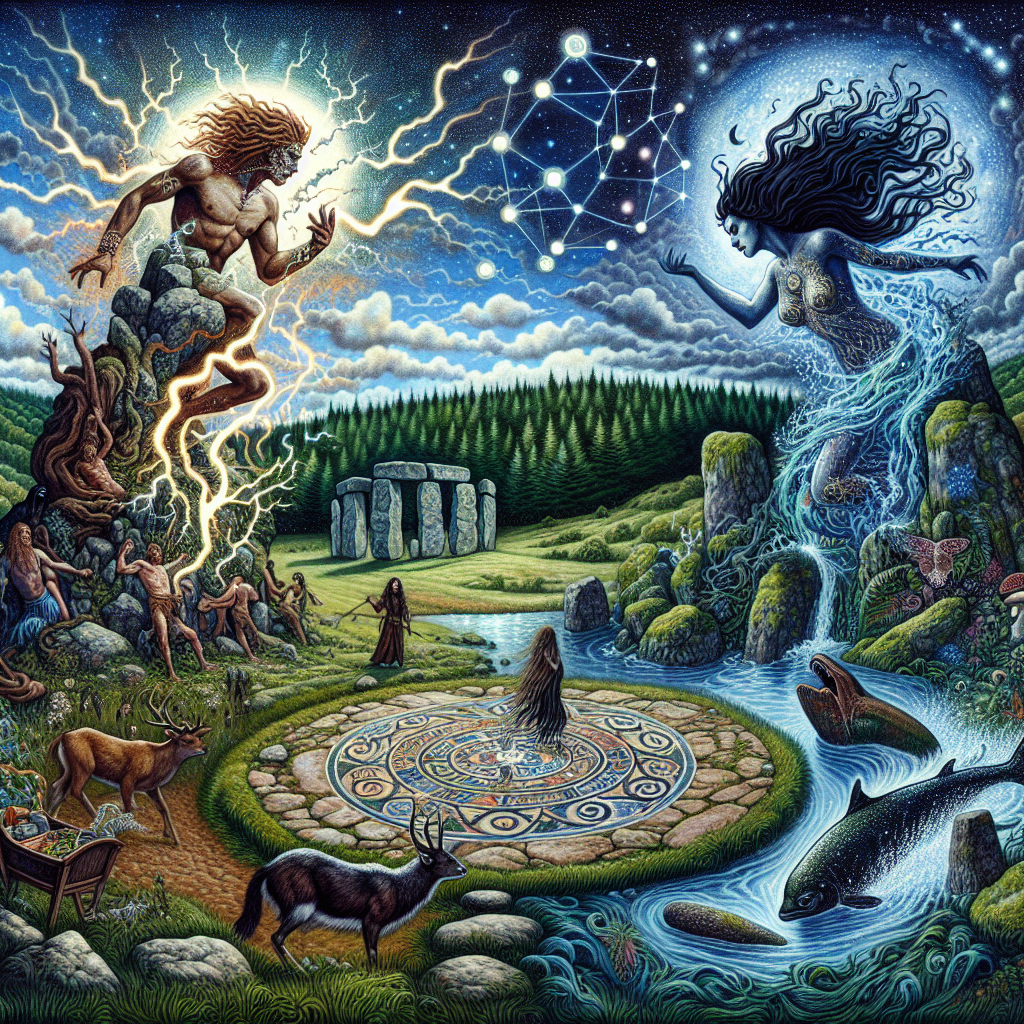As an Amazon Associate I earn from qualifying purchases.
↻
Last updated: December 24, 2025

Encompassing mythologies from around the world and spanning centuries of storytelling, pagan mythology is a fascinating exploration of human belief systems before the advent of monotheistic religions. These myths and legends are a testament to the vast diversity and richness of human imagination, revealing much about our ancestors' understandings of the world, the cosmos, and the mysteries of life and death.
Pagan mythology, also known as polytheistic or indigenous mythology, refers to the traditional stories and beliefs of ancient, pre-Christian cultures. It includes the myths of ancient Greece, Rome, and Celtic, Nordic, Slavic, African, and Native American traditions, among others. Over the centuries, these mythologies have not only been a source of entertainment and folklore but have also shaped cultural paradigms, customs, and moral values. Even in our modern world, pagan myths continue to influence literature, pop culture, and even some aspects of contemporary religious thought.
Historically, pagan myths were not just simple tales spun for amusement; they served as a cultural framework. They explained natural phenomena, the changing seasons, life cycles, and moral and ethical behavior. For example, ancient Greeks believed in the story of Persephone's yearly descent into Hades as an explanation for winter's arrival and her ascent as the promise of spring. This mythological tale imbued the Greeks with a sense of order and security, linking their lives with a greater cosmic pattern.
Fast-forwarding to the 21st century, it is fascinating to discover that 196,800 Google searches are conducted every second on average globally, and a significant number of these searches relate to myths, legends, and folklore. This compelling statistic underlines the timeless human curiosity about pagan mythology, suggesting that their presence in human consciousness remains undiminished despite the march of monotheistic faiths.
One intriguing aspect of pagan mythology lies in its sheer diversity. Each cultural tradition offers its unique pantheon of gods, goddesses, heroes, and monsters, each with their narrative and symbolic meanings. Think of the powerful Norse god Thor with his thunder-making hammer, the Greek goddess Athena with her wisdom and courage, or the African trickster god Anansi, spinning his tangled web of mischief. These characters, born from the marriage of human imagination and the mysteries of the natural world, continue to resonate deeply with us, inviting exploration and interpretation.
Infused with timeless wisdom, brimming with heroes, gods, and mystical creatures, pagan myths are wellsprings of inspiration and insight. Their enduring appeal invites us to delve deeper, exploring our shared humanity and the complex tapestry of beliefs that have shaped it. Whether we regard them as universal allegories, profound philosophical inquiries, or mere tales spun for entertainment, their impact on human culture remains evident in our modern narratives and shared global consciousness.
What Does Pagan Mythology Reveal in Myths and Legends?
In deciphering the secrets of myths and legends, Pagan Mythology holds a treasure trove of insightful narratives. Rooted in ancient practices and beliefs, Pagan Mythology opens a window to historic cultures, encapsulating their understanding of the cosmos, human nature, life, and death. These captivating myths and stories cover everything from gods and goddesses to heroes and monsters, embodying values and metaphysical ideas of the societies they emerged from. As we further unpack these legends in the next section, explore with us the intriguing world of Pagan Mythology and uncover what it can reveal about our ancient forebears and their fascinating beliefs.
The Roots of Pagan Mythology
Pagan mythology, often linked to ancient religious practices and spiritual beliefs, is an intricate tapestry woven from myriad cultural threads. It draws on a diverse range of influences, often tied to specific regions or nations and colored by the natural world, regional traditions, and societal norms of those areas. From the ancient Druids of Britain, the Norse gods of Scandinavia, to the Slavic and Baltic pagan deities, the breadth and complexity of pagan mythology are deeply intertwined with cultures worldwide.
Understanding Pagan Mythology Through Iconography
Pagan Mythology is historically preserved through varied forms of iconography, for example, sculptures, paintings, and manuscripts. These preserved artworks act as a rich source of understanding the diverse set of beliefs that have been handed down throughout history.
Consider the Celtic mythology, which is full of tales of mystical beings, heroic deeds, and detailed depictions of gods and goddesses. There you will find Cernunnos, the horned god of fertility, depicted in the Gundestrup Cauldron, a remarkable artifact from Iron Age Europe.
Dynamics of Pagan Mythology
The allure of pagan mythology often lies in its flexibility and openness to individual interpretation. Unlike strictly codified belief systems, pagan faiths emphasize personal experience and connection with spiritual entities. This approach leads to richly varied storytelling traditions, with individual cultures and regions developing their own unique interpretations of common themes.
For example, in Norse mythology, the god Odin, who was associated with wisdom, healing, and magic, was seen by some as a benevolent deity, while others feared him as a wrathful, unpredictable figure. This varying perspective creates a rich dynamic within the mythology itself, imbuing it with a depth and complexity often unheard in other spiritual traditions.
Sacred Rituals and Festivities in Pagan Mythology
Festivities and rituals play a significant role in pagan mythology. The eight spokes of the Wheel of the Year represent significant festivals or “sabbats,” revered in various pagan traditions. These sabbats coincide with changes in seasons, reflecting the deep respect for the natural world inherent in pagan belief systems.
The Significance of Pagan Mythology Today
Today, pagan mythology continues to see a resurgence, with many people exploring these rich traditions as they search for more personal, less dogmatic spiritual paths. Practices such as Wicca and Druidism have gained popularity, often drawing heavily on older pagan traditions and god/goddess archetypes.
Indeed, many modern practices, rituals, and celebrations also find their roots in ancient pagan traditions. For instance, the Christmas tree and the holiday wreath are rooted in Germanic pagan practices, while Easter borrows its name from Eostre, the Anglo-Saxon goddess of dawn and spring.
According to Pew Research Center, an estimated 1 million people in the United States alone identified as Pagan or Wiccan in 2014. Thus, the influence of pagan mythology continues to endure, reflecting the timeless depth and appeal of these ancient stories and celebrations. It remains a testament to the resilience and malleability of a tradition that refuses to be silenced, despite societal changes and evolving belief systems.
1.
Q: What is pagan mythology?
A: Pagan mythology refers to the collection of stories, beliefs, and practices associated with various pagan religions, often predating the advent of monotheistic faiths. These mythologies often include a pantheon of gods and goddesses, heroes, mythical creatures, and narratives about the creation of the world, life, death, and nature.
2.
Q: What are some common examples of pagan mythologies?
A: Some common pagan mythologies include the Norse mythology of the Scandinavian peoples, the Greco-Roman mythology of ancient Greece and Rome, the Slavic mythology of Eastern Europe, and the Celtic mythology of the British Isles, among others.
3.
Q: Are pagan mythologies just ancient stories, or do people still practice these religions today?
A: While many pagan mythologies are rooted in ancient civilizations, there are indeed modern practitioners who follow these traditions today. This is often referred to as modern paganism or neo-paganism, and includes practices like Wicca, Druidism, and a resurgence in the interest of Norse, Greek, and other traditional pagan beliefs.
4.
Q: How do pagan mythologies view the concept of divinity?
A: Divinity in pagan mythologies is often polytheistic, meaning they believe in multiple gods and goddesses. Each deity commonly has their own domain or aspects of life, nature, or the universe that they oversee. Some pagan religions also embrace a duotheistic view, with a God and Goddess representing different aspects of a universal whole.
5.
Q: How does pagan mythology explain creation?
A: This largely depends on the specific mythology. Most pagan mythologies have their own unique creation story, each detailing how the universe, earth, and life came to be. For example, in Norse mythology, it's believed the world was created from the body of a slain giant, while in Greek mythology, the world emerged from chaos.
6.
Q: Are there common themes in pagan mythology?
A: Yes, there are common themes present in many pagan mythologies, such as tales of creation, the cycle of the seasons, life and death, the hero's journey, divine intervention in mortal affairs, and the struggle between order and chaos.
7.
Q: Is pagan mythology related to witchcraft?
A: Some modern forms of witchcraft, such as Wicca, draw heavily from certain pagan mythologies, incorporating the worship of ancient gods and goddesses, the celebration of seasonal festivals, and the use of magical rituals. However, not all pagan religions involve witchcraft, and not all witchcraft is necessarily pagan.
8.
Q: Is there a sacred text for pagan mythology like the Bible or Quran?
A: Most pagan religions don't have a centralized sacred text as in Christianity or Islam. Instead, their myths and stories were often passed down orally and later recorded by historians. However, some texts like the Norse Eddas, the Celtic Mabinogion, or the Greek Theogony, are considered vital resources for understanding these mythologies.
9.
Q: How do practitioners of pagan mythologies worship their deities?
A: Practices vary widely but may include prayer, meditation, rituals, magic, sacrifices and offerings, and the celebration of specific festivals or holidays connected to nature's cycles and the deities.
10.
Q: Is there a moral code in pagan mythologies?
A: While pagan mythologies may not have explicit commandments like some religions, they often promote concepts of respect for nature, honor, courage, wisdom, and balance. The interpretations of these principles can vary from tradition to tradition though.

Conclusion
In examining Pagan mythology, we can gain comprehensive insights into the cultures that once revolved around these traditions and belief systems. The breadth of practices and interpretations inherent in Pagan mythology is testimony to its vibrant variety. Pagan cultures held deep reverence for nature and its cycles, aligning their everyday life and codes of ethics with the changing seasons, lunar cycles, and elemental forces. Additionally, the existence of diverse pantheons, embodying various archetypal characteristics, further stress on the Pagan ethos of individuality and personal spirituality.
While certain aspects of Pagan mythology seem idiosyncratic in the context of contemporary beliefs, its focus on personal connection, reverence for earth's processes and sacred feminine are increasingly finding resonance today. Indeed, Pagan mythology’s inherent connection to nature and the environment can offer profound lessons in an age grappling with ecological crises. Lastly, it is the very inclusivity, multiplicity and allowance for personal spiritual exploration that make Pagan mythology a rich field for scholarship and understanding; a wellspring of alternative methods of engaging with the world around and within us. This exploration also helps underline the commonalities of human spirituality and wisdom across differing cultures and eras.
Amazon and the Amazon logo are trademarks of Amazon.com, Inc, or its affiliates.
Continue Your Magical Journey
Free Witchcraft Starter Kit
Get 6 free printable PDFs: grimoire pages, moon calendar, spells, crystals, herbs, and tarot journal.
We respect your privacy. Unsubscribe anytime.
Enhance Your Practice
As an Amazon Associate, I earn from qualifying purchases.

